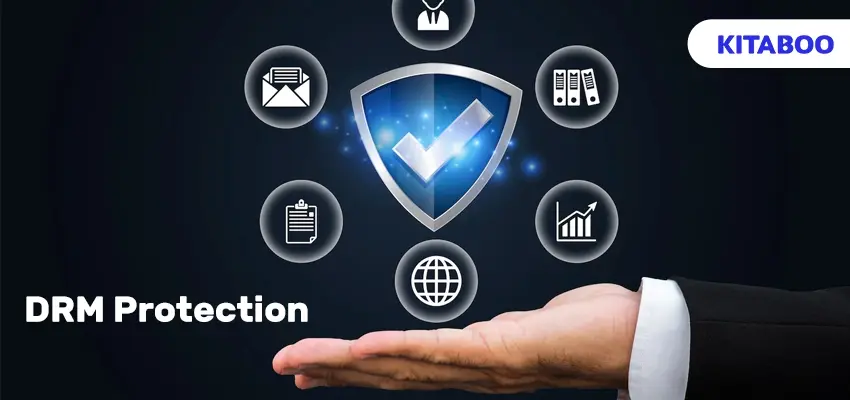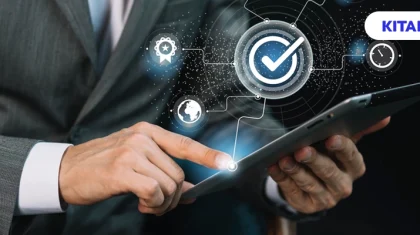
DRM Protection and eBooks: How It Shapes Our Reading Experience
In today’s world, DRM protection, or Digital Rights Management, plays a pivotal role in ensuring both content security and the seamless accessibility of digital books. This transformative technology is particularly significant for higher education learners, providing a secure environment for educational materials in the digital realm.
On the other hand, eBooks, the digital counterparts of traditional printed books, have become increasingly prevalent, accessible through devices such as eReaders, smartphones, and tablets.
In this context, collaborative efforts with digital textbook platforms like KITABOO stand as a testament to the commitment to content security and accessibility. This platform not only provides a user-friendly interface for students and educators but also incorporates robust DRM measures to safeguard the intellectual property of authors and publishers.
Table of Contents:
I. Why is DRM Protection Important for Ebooks?
- Safeguards the Intellectual Property of Authors and Publishers
- Protects Revenue and Reduces Costs
- Enhances the Confidence of Publishers
- Promotes a Diverse Range of Content in Electronic Formats
- Ensures a Consistent User Experience
II. 4 Ways in Which DRM Protection for eBooks Can Enhance the Reading Experience
- Ensures Portability
- Offers Accessibility
- Introduces Interactive Features
- Enables Multi-Device Syncing
III. Conclusion
Why is DRM Protection Important for Ebooks?
In the modern digital world, DRM Protection for eBooks is significant for several reasons:
Safeguards the Intellectual Property of Authors and Publishers
DRM-protected eBooks safeguard the intellectual property of authors and publishers and respect both the rights of content creators and the expectations of consumers. This way, it ensures that the hard work and creativity invested in crafting digital content are protected, discouraging unauthorized distribution, reproduction, or sharing.
Protects Revenue and Reduces Costs
Widespread piracy and unauthorized usage of eBooks is a big concern in the digital learning world. DRM protection for eBooks ensures that protection is guaranteed for the revenue stream of authors and publishers. It ensures that people who want to access the content must acquire it legally, supporting the creators financially.
DRM-protected eBooks restrict unauthorized copying and distribution of eBooks and limit the number of devices on which an eBook can be accessed. Although DRM protection doesn’t eliminate piracy, it acts as a deterrent which can help in avoiding significant financial losses due to unauthorized access and distribution.
Enhances the Confidence of Publishers
Publishers are more likely to release digital versions of their content when they have mechanisms like DRM protection in place. It gives them confidence that their investment in creating and distributing eBooks will be protected from unauthorized use.
DRM protection for eBooks enhances content security, allows controlled access, reduces the risk of unauthorized modifications, and safeguards the revenue generated from legitimate sales. Publishers can have confidence that their investment in creating and distributing digital content is less susceptible to financial losses due to piracy.
Promotes a Diverse Range of Content to learners in Electronic Formats
DRM protection helps alleviate publishers’ concerns about widespread piracy, making them more willing to release various content in electronic formats. The assurance of content security encourages publishers to digitize a broader range of titles.
Digital formats, supported by DRM, allow publishers to reach a global audience without the challenges associated with physical distribution. This support enables publishers to experiment with interactive elements, multimedia, and other innovative features.
Ensures a Consistent User Experience for learners
DRM protection ensures a consistent user experience by maintaining control over how the content is accessed, enabling device synchronization, and ensuring that the authorized user has a consistent experience across their approved devices. It maintains a reliable reading experience and helps publishers balance content protection with user expectations and rights.
4 Ways in Which DRM Protection and eBooks Can Enhance the Reading Experience of Learners
Here are the 4 ways in which DRM protection and eBooks can accelerate the reading experience:
1. Ensures Portability
Ebooks allow readers to carry an entire library in a single device, making it easy for learners pursuing higher education to access a variety of titles wherever they go. DRM protection:
- Ensures this convenience without compromising on content security and allowing users to access their digital library across various devices.
- Follows a controlled authentication process where authentic users can download and read these eBooks on different platforms
- Ensures that this access is granted only to authorized users and devices, balancing portability and content security.
Especially when it comes to students pursuing higher education, DRM protection ensures that educational materials remain accessible to authorized users. It brings about a seamless and secure learning experience tailored to the needs of higher education students.
2. Offers Accessibility
Digital formats go beyond traditional print by offering a range of customizable features, including fonts, text sizes, and background colors, ensuring a tailored reading experience for each higher education student.
Here’s how it enhances accessibility:
- Preserves digital content’s integrity while offering features catering to individual needs.
- Provides customizable settings such as font size, background color, and text-to-speech options.
- Allows readers to personalize their reading experience.
- Supports navigation aids and search functions, enhancing the overall accessibility for readers with different preferences and needs.
In this context, note that KITABOO, one of the leading digital textbook platforms, can help you with DRM-protected eBooks and ensure that your content is safe and reaches the right audience at the right time.
3. Introduces Interactive Features
Some eBooks include interactive elements such as hyperlinks, multimedia, and annotations. DRM protection:
- Safeguards these features, ensuring they are experienced as intended by the creators.
- Introduces interactive features and ensures that these interactive components are preserved and function as intended
- Maintains the integrity of the eBook’s interactive elements, providing readers with an immersive and enriched experience
4. Enables Multi-Device Syncing
DRM-controlled access allows higher education readers to sync their progress across multiple devices, allowing them to seamlessly switch between devices. DRM protection helps in:
- Mitigating the loss of users’ bookmarks, highlights, or notes.
- Enabling multi-device syncing by securely managing user access across different platforms.
- Ensuring that this syncing capability is restricted to authorized users, preventing unauthorized sharing or tampering.
- Enhancing the flexibility of reading allows individuals to switch between devices without losing their place in the eBook.
Conclusion
DRM protection and eBooks bring valuable improvements to the digital reading experience. Striking the right balance is crucial for leaders in higher education and publishers to avoid unnecessary restrictions on intellectual property rights. When used wisely in the higher education landscape, this combination has the power to redefine how we engage with educational content.
For more information on creating accessible, immersive, and secure digital content with DRM protection, contact the experts at KITABOO.
Write to us at KITABOO@hurix.com to know more!
Discover how a mobile-first training platform can help your organization.
Kitaboo is a cloud-based platform to create, deliver & track mobile-first interactive training content.





